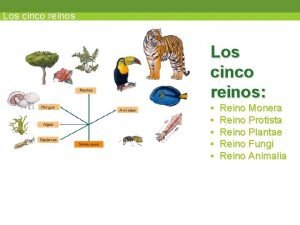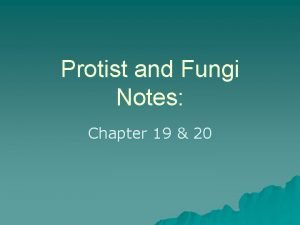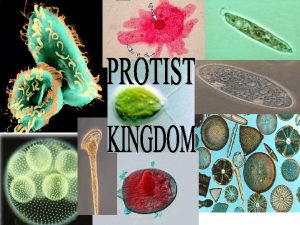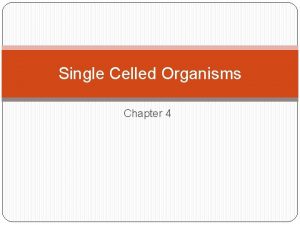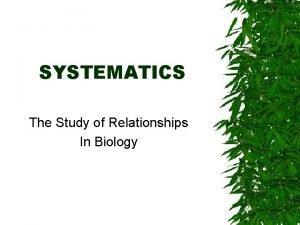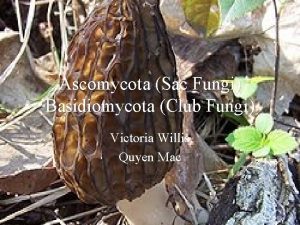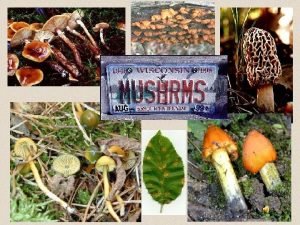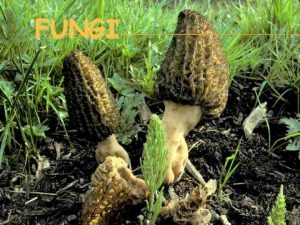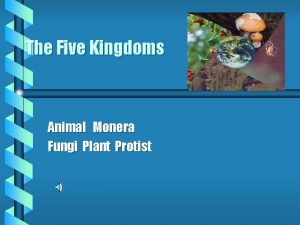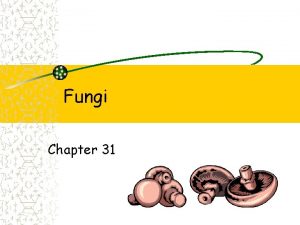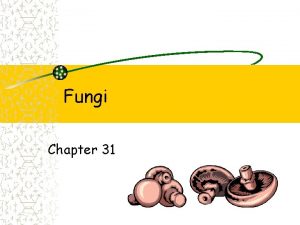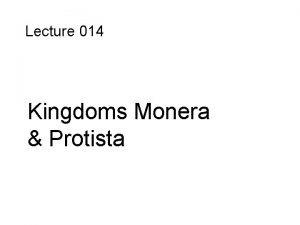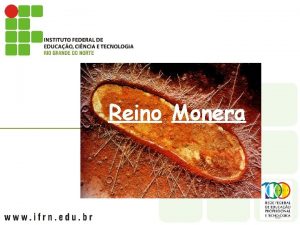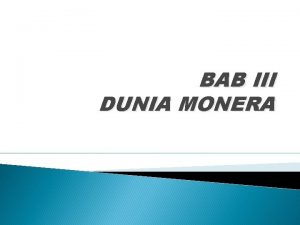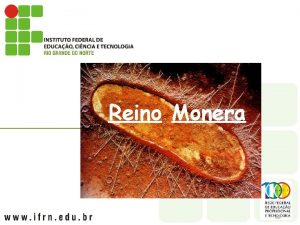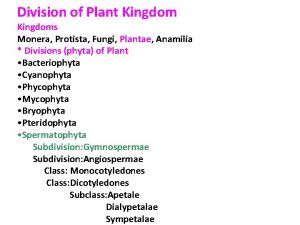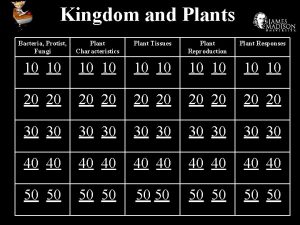5 KINGDOMS ANIMAL PLANT FUNGI PROTIST MONERA Animal















- Slides: 15

5 KINGDOMS – ANIMAL – PLANT – FUNGI – PROTIST – MONERA

Animal • heterotrophic, multicellular organisms with organs or tissues. • All have a larval or embryonic stage of development.

Animal • Animals also exhibit different kinds of symmetry: asymmetry, spherical, radial, and bilateral • Finally, animals can be invertebrates (no backbone) or vertebrates (with backbone).

Plant • all plants have chlorophyll, cell walls of cellulose, • and tissues and organs. Bryophyta- plants are primitive and lack vascular tissue and true roots. Examples include mosses and liverworts. Tracheophyta- plants are more advanced and contain vascular tissue.

Plants • Pterophyta- plants reproduce by spores and grow from underground stems. Example include ferns and horsetails. Coniferophyta- plants produce naked seeds in cones and soft wood. Many are evergreens. – Examples include redwoods, pines, cypress, and junipers

Plants • Anthophyta- plants are the most advanced and produce flowers. – Class monocotyldonae plants have seeds that contain one cotyledon, leaves with parallel veins, flower parts in multiples of three, no cambium, and scattered vascular bundles in the stem – Class dicotyledonae plants have seeds that contain two cotyledons, leaves with netted veins, flower parts in multiples of four and five, cambium, and vascular bundles in a cylinder.

Fungi • fungi - multicellular, parasitic; has cell walls made of chitin. – Digestion is extracellular • secrete enzymes • reabsorb digested nutrients. – Circulation • diffusion – Reproduction – asexual through spores – sexual where strains of fungi meet

Protists • Protists -are grouped according to whether they are animal-like, plant-like, or fungus-like. – Animal-like protozoans. – Fungus-like protists • mxyomycota ("plasmodial slime molds") – Plant-like protists • contain chlorophyll. – Reproduction Sexual & Asexual type

Monera • Prokaryotes-are the earliest and simplest cells on Earth – Digestion is extracellular (outside the cell) and nutrients are absorbed into the cell. – parasitism, harm is caused to the host. – commensalism, one organism benefits while the other is unaffected. – mutualism, both organisms benefit.

Monera • REPRODUCTION - Most organisms in the Kingdom Monera – binary fission (asexual) – conjugation (sexual).

TAXONOMY OF MAN • • • Kingdom: Animalia Phylum: Chordata Class: Mammalia Order: Primates Superfamily: Hominoidea Family: Hominidae Subfamily: Homininae Tribe: Hominini Genus: Homo Species: H. sapiens Binomial name. Homo sapiens

Peas • • • Kingdom: Plantae Division: Magnoliophyta Class: Magnoliopsida Order: Fabales Family: Fabaceae Subfamily: Faboideae Tribe: Vicieae Genus: Pisum Species: P. sativum Binomial name. Pisum sativum

Mushroom • Kingdom: Fungi • Division: Basidiomycota • Class: Homobasidiomycetae • Subclass: Hymenomycetes • Order: Agaricales • Family: Amanitaceae • Genus: Amanita • Species A. muscaria • Binomial name. Amanita muscaria

Bacteria • Kingdom: Bacteria • Phylum: Proteobacteria • Class: Gamma Proteobacteria • Order: Enterobacteriales • Family: Enterobacteriaceae • Genus: Escherichia • Species: E. coli • Binomial name Escherichia coli

FLY • Kingdom: Animalia • Phylum: Arthropoda • Class: Insecta • Order: Diptera • Family: Drosophilidae • Genus: Drosophila • Species: D. melanogaster • Binomial name. Drosophila melanogaster
 Reino monera y reino protista
Reino monera y reino protista Kingdom protista characteristics
Kingdom protista characteristics Penicillin protist or fungi
Penicillin protist or fungi Ciri protista
Ciri protista Euglena eukaryotic or prokaryotic
Euglena eukaryotic or prokaryotic Sporozoa
Sporozoa Animal-like protist
Animal-like protist Protists
Protists Unknown bacteria
Unknown bacteria Monera protista fungi plantae animalia
Monera protista fungi plantae animalia Protista plantae
Protista plantae Monera protista fungi plantae and animalia
Monera protista fungi plantae and animalia Animalia fungi plantae
Animalia fungi plantae Sac fungi kingdom
Sac fungi kingdom Deuteromycetes
Deuteromycetes Basidiomycota rusts and smuts
Basidiomycota rusts and smuts
